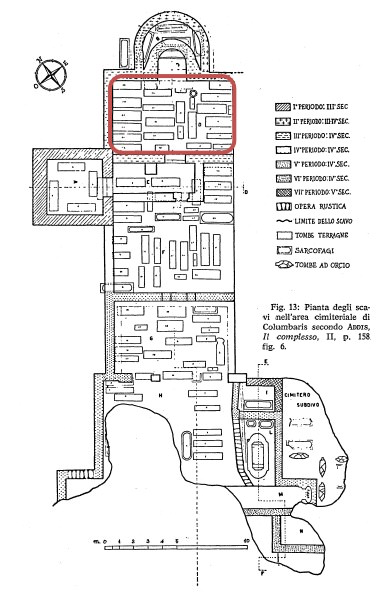Inscription of Maximus
In a sheep pen not far from the Columbaris basilica area they found a marble slab 191 cm long, divided into four fragments, with an engraved text (fig. 1).

It was stolen from the cemetery basilica to the North of the area and was originally the epigraphical tabula placed by Silbanos on the cover of the sarcophagus of his father Maximus, who died aged fifty. The text translated says: «To Maximus in good memory who lived well for more or less fifty years. His son placed this slab. (Rest) in peace. Silvano», with letters in different heights based on the rows they are arranged in (fig. 2).

The epigraph is dated V century A.D. and according to testimony comes from tomb 20 in the D sector of the cemetery basilica (fig. 3).

Alongside the text, there are three symbols dear to the Christian iconography of the early centuries: three Christological monograms, symbols formed by the letters of the Greek alphabet Chi (X) and Ro (P) to form the name of Christ (fig. 4), a dove with an olive branch in its beak (fig. 4) and a large ship (fig. 4). The dove symbolises the soul of the deceased finding peace after death. Finally, the ship represents both the path taken by the deceased to afterlife and the Church which, led by Christ, leads to salvation.

Bibliografia
- O. ADDIS, Relazione sui lavori di ricerca replicata ed ampliata in Cornus, Regione Columbaris. 23 luglio - 31 ottobre 1962 (Archivio della Soprintendenza per i Beni Archeologici per le province di Cagliari e Oristano), p. 11.
- O. ADDIS, Il complesso paleocristiano di Cornus secondo i risultati di un recente scavo, in Atti del XIII Congresso di storia dell'architettura (Cagliari, 6-12 aprile 1963), I, Roma, 1966, pp. 181-190.
- A. CORDA, Le iscrizioni cristiane della Sardegna anteriori al VII secolo, Città del Vaticano 1999, p. 140.
- G. FARRIS, Le aree paleocristiane di Cornus, Oristano 1993, p. 54.
- L. GAMBASSI s.v. Nave, in F. BISCONTI (a cura di), Temi di Iconografia cristiana = Sussidi allo studio delle Antichità cristiane, XIII, Città del Vaticano 2000, pp. 228-230.
- G. MAETZKE, Scavi e scoperte nel campo dell’archeologia cristiana negli ultimi dieci anni in Toscana e in Sardegna, in Atti del II Congresso Nazionale di Archeologia Cristiana (Matera, Venosa, Melfi, Massafra, Taranto, Canosa, Foggia 25-31 maggio 1969), Roma 1971, pp. 311-335.
- A. MASTINO, Cornus nella storia degli studi con un catalogo delle iscrizioni rinvenute nel territorio del comune di Cuglieri, Cagliari 1984, p. 147-148.
- G. G. PANI, L'epigrafia cimiteriale di Cornus: alcune riflessioni, in AA.VV., L'archeologia romana e altomedievale nell'Oristanese. Atti del Convegno di Cuglieri (22-23 giugno 1984) = Mediterraneo tardoantico e medievale, Scavi e ricerche, 3, Taranto 1986, pp. 95-101.
- P. G. SPANU, Le navi di Cornus, in P. G. SPANU (a cura di), con la collaborazione di M. C. OPPO e A. BONINU, Insulae Christi. Il cristianesimo primitivo in Sardegna, Corsica e Baleari = Mediterraneo tardoantico e medievale. Scavi e ricerche 16, Oristano 2002, pp. 281-288.
- P. TESTINI, Il complesso paleocristiano di Cornus (Regione Columbaris) in Sardegna, in Actas del VIII Congreso Internacional de Arqueologia Cristiana (Barcelona, 5-11 octubre 1969), Barcellona 1972, pp. 537-561.
- G. WILPERT, La fede della chiesa nascente secondo i monumenti dell’arte funeraria antica, 1938, p. 128.

 VR
VR